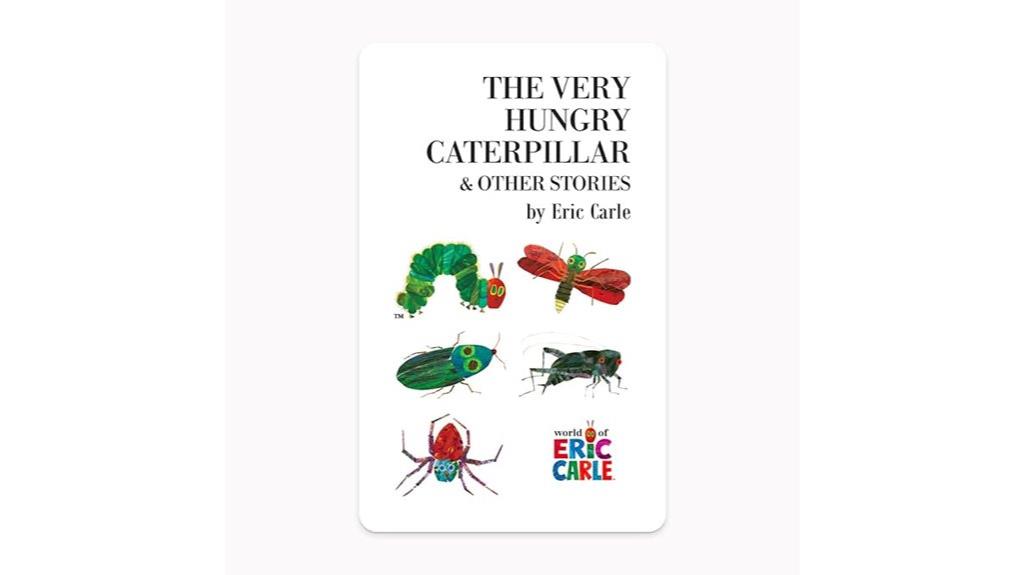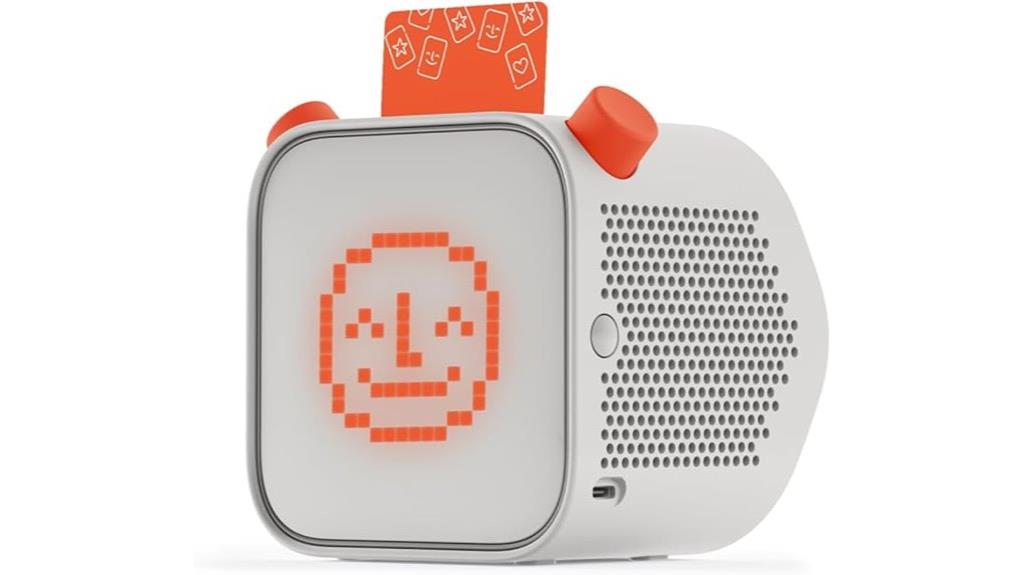I believe choosing between the Yoto Player and Toniebox depends on what you value most—digital customization or physical collectibles. I prefer the Yoto for its vast library, flexibility, and ability to upload my own content, while the Toniebox wins for its durable, kid-proof design and charming figurines. Both are excellent for screen-free fun and safety. If you want to see how they compare across features, keep going—you’ll find all the details you need.
Key Takeaways
- Yoto offers extensive digital content customization with over 1,000 cards, ideal for varied media and personalized stories.
- Toniebox features physical figurines for curated content, emphasizing simplicity, durability, and craft-based personalization.
- Yoto’s sleek, impact-resistant design balances style and durability; Toniebox’s soft shell excels in shock absorption for active kids.
- Both devices provide long battery life (~24 hours), portability, and screen-free operation, suitable for on-the-go use.
- Yoto’s digital flexibility suits tech-savvy families, while Toniebox’s tactile approach appeals to children and parents favoring physical media.
YOTO The Very Hungry Caterpillar & Other Stories Audio Card for Kids

If you’re looking for a kid-friendly audio option that combines classic storytelling with simple, intuitive use, the YOTO The Very Hungry Caterpillar & Other Stories Audio Card is a great choice. It features Eric Carle’s beloved “The Very Hungry Caterpillar” plus four more stories, all brought to life with engaging sound. With a total runtime of 26 minutes, it’s perfect for children aged 1 and up. Just insert the card into a compatible Yoto device to play, and remove it to stop. Its user-friendly design, parental controls, and screen-free format make it safe and easy for kids to enjoy hours of educational, imaginative storytelling.
Best For: parents and caregivers seeking a safe, screen-free, and educational audio storytelling option for children aged 1 and up.
Pros:
- Engages children with classic stories like “The Very Hungry Caterpillar” and more, fostering early literacy and love for stories.
- Easy to use with a simple insert and remove design, suitable for young children.
- Parental controls and a screen-free format ensure safe, ad-free entertainment.
Cons:
- Limited to pre-loaded stories; cannot download new content directly onto the card.
- Requires a compatible Yoto Player or Mini device for playback, which may involve additional cost.
- The total runtime of 26 minutes may require multiple sessions for longer storytelling needs.
Yoto Mini (2024 Edition) Bluetooth Audio Player with Disney Pixar Bundle

The Yoto Mini (2024 Edition) Bluetooth Audio Player with Disney Pixar Bundle stands out as an excellent choice for parents seeking a screen-free, portable entertainment option that combines ease of use with engaging content. This device functions as a speaker or can be used with headphones, making it perfect for travel or on-the-go fun. It includes a Disney Pixar bundle with stories from Toy Story, Brave, and others, plus access to over 1000 cards with music, podcasts, and activities. Its simple setup, parental controls, and safe, ad-free environment make it a reliable and versatile option for children, ensuring they enjoy quality entertainment without screens.
Best For: parents seeking a safe, screen-free, portable entertainment device for children that offers engaging stories, music, and activities.
Pros:
- Easy to set up and operate with a simple insert-and-play system and free app control
- Curated safe, ad-free content suitable for children with parental controls included
- Versatile functionality as a speaker, sleep sound machine, alarm clock, or headphone-compatible device
Cons:
- Limited to content available through the device’s ecosystem, potentially requiring additional card purchases for more variety
- May be less suitable for children who prefer visual or interactive screens for entertainment
- Battery life of up to 14 hours might require frequent recharging during extended travels
YOTO Player (3rd Gen.) Kids Bluetooth Audio Speaker

Designed for children aged 3 to 12 and built with both safety and creativity in mind, the YOTO Player (3rd Gen.) offers a screen-free listening experience that parents can trust. It’s an all-in-one device that plays stories, music, podcasts, and more, all curated to be safe and ad-free. Setup is straightforward—just insert an Audiobook Card to start listening and use the large dials or the free Yoto App to control volume and tracks. With a vivid pixel display, nightlight, alarm clock, and portable features, it’s versatile for bedtime, travel, or independent play. Plus, with 32GB storage, it offers over 600 hours of offline entertainment.
Best For: parents and caregivers seeking a safe, engaging, and versatile screen-free audio device for children aged 3-12+ that promotes independent learning and imaginative play.
Pros:
- Easy to set up and operate with simple controls and a user-friendly app
- Curated, safe content including stories, music, podcasts, and soundscapes without ads or cameras
- Includes multiple features like a nightlight, alarm clock, room thermometer, and portable design with long battery life
Cons:
- Limited to audio content with no visual or interactive elements beyond the pixel display
- Content library primarily relies on physical Yoto cards, which may require additional purchase
- Some users might find the device’s feature set limited for older children seeking more advanced tech or interactive features
Factors to Consider When Choosing Yoto Player Vs Toniebox Review

When choosing between the Yoto Player and Toniebox, I consider factors like content selection options and how durable each device is. Ease of use and safety features are also key, along with battery life and portability for on-the-go use. These points help me decide which device best fits my child’s needs.
Content Selection Options
Choosing between the Yoto Player and Toniebox often comes down to how much control and variety you want over content. Yoto offers access to over 1,000 cards, including books, music, podcasts, and soundscapes, giving kids and parents a wide range of options. Its digital card system makes it easy to select, purchase, and customize content, providing flexibility and user control. In contrast, Toniebox uses collectible figurines called Tonies, each preloaded with specific stories or songs. While this simplifies content choices and reduces screen time, it limits customization and variety. The content on Tonies is curated by creators or parents, and updates are less flexible compared to Yoto’s downloadable and create-your-own content options. Overall, Yoto provides more extensive and customizable content options than the more curated Toniebox.
Device Durability and Design
Both the Yoto Player and Toniebox are built to withstand the rough handling that comes with young children, but they do so in different ways. The Yoto Player features a sturdy plastic case with a tactile interface, making it durable yet sleek. Its screen and controls are designed to resist minor impacts, though they may be more prone to scratches. In contrast, the Toniebox has a soft, rubberized outer shell that absorbs shocks, making it highly impact-resistant if dropped. This flexible exterior is ideal for active kids who might be more prone to rough handling. Overall, the Toniebox emphasizes durability through its shock-absorbing design, while the Yoto Player offers a more refined, long-lasting build that balances sturdiness with style.
Ease of Use
Ease of use plays a significant role in selecting the right device for young children. Both Yoto Player and Toniebox are designed for simple operation, requiring just inserting a card or figure to start playback. The Yoto Player uses physical dials for volume and track control, providing tactile interaction that kids can easily understand. In contrast, the Toniebox has a single large button for power and volume, making it straightforward to operate. Setup for both devices is quick and easy—just insert a card or figure and press play. The Yoto Player offers an app for added control, giving parents and children more flexibility, while the Toniebox relies mainly on physical controls. Their screen-free operation and minimal buttons make them accessible, even for young children with limited technical skills.
Safety Features
When evaluating Yoto Player and Toniebox, safety is a top priority, especially since these devices are designed for young children. Both prioritize child safety by removing cameras, microphones, and internet browsing features, reducing exposure to online risks. Yoto devices include parental controls that allow me to restrict content and manage usage, giving me peace of mind. Toniebox offers a durable, soft, drop-resistant design, perfect for active little ones. The screen-free setup minimizes the risk of inappropriate content and limits screen time. Both devices feature secure content management, physical volume limits, and tamper-proof construction to create a safe listening environment. These safety features make either device a reliable choice for parents who want to ensure their children enjoy content safely.
Battery Life & Portability
Battery life and portability are essential factors when choosing between the Yoto Player and Toniebox, especially if your child enjoys listening on the go. A longer battery life means less frequent recharging, making it perfect for trips or extended outdoor use. Some models can last up to 24 hours on a single charge, ensuring uninterrupted entertainment. Portability depends on the device’s size and weight; a compact, lightweight design allows kids to carry it comfortably without fatigue. The built-in rechargeable batteries mean no constant connection to power outlets, supporting use anywhere. Whether heading to a park or traveling, a device with good battery life and easy portability ensures your child can enjoy their favorite stories anytime, anywhere.
Customization Capabilities
Choosing between the Yoto Player and Toniebox largely depends on how much you want to customize your child’s listening experience. I find that Yoto offers extensive digital customization, with over 1,000 cards, including Make Your Own options for personalized content. You can easily upload or create your own audio files, making it highly flexible. On the other hand, Toniebox focuses on creating custom figurines—Tonies—with personal recordings, which involves some physical crafting. While this adds a unique touch, it’s less versatile than Yoto’s digital approach. Both systems let you personalize content, but Yoto’s broad digital library and user-created options provide more extensive and adaptable customization, giving parents greater control over what their children listen to.
Frequently Asked Questions
How Do the Battery Lives Compare Across the Yoto and Toniebox Devices?
The Yoto Player generally has a longer battery life, lasting around 12-14 hours on a single charge, while the Toniebox tends to last about 7-8 hours. I’ve found that the Yoto’s extended battery makes it more suitable for long trips or extended playtime without frequent recharging. The Toniebox is still convenient, but I appreciate the Yoto’s durability for active use.
Are There Any Subscription Fees for Accessing Content on Either Device?
No, there are no subscription fees for accessing content on either the Yoto Player or Toniebox. You buy the device and then purchase or load content separately through their respective platforms. I find this flexibility great because you’re not locked into ongoing costs, and you can choose what content to buy or upload. It makes both devices budget-friendly and customizable for your child’s preferences.
Can Both Devices Be Used Internationally With Different Power Outlets?
Both devices can be used internationally, but you’ll need the right power adapters since outlets vary worldwide. I always make sure to get compatible plugs for my Yoto Player or Toniebox when traveling abroad. Keep in mind, the devices themselves are usually compatible with different voltages, but you should double-check the power requirements. Overall, with the proper adapters, I find both are quite travel-friendly.
Which Device Offers Better Durability for Travel and Outdoor Use?
I find the Toniebox to be more durable for travel and outdoor use because of its sturdy design and soft, impact-resistant material. It’s built to withstand bumps and drops, making it ideal for active kids on the go. The Yoto Player, while durable, feels more fragile with its plastic components. If your child loves outdoor adventures, I’d recommend the Toniebox for better resilience and peace of mind.
Are Parental Controls Available on Both Yoto and Toniebox Platforms?
Yes, both Yoto and Toniebox offer parental controls, but they differ in how they function. I’ve found that Yoto provides more detailed controls through its app, allowing me to limit content and set usage times easily. Toniebox offers simpler controls, mainly focusing on volume limits and content access. Overall, I appreciate both for their safety features, but Yoto’s controls feel more extensive for peace of mind.
Conclusion
So, which one truly wins in the battle of Yoto vs Toniebox? Honestly, it depends on what your little one loves and your priorities. Both offer fantastic features and engaging content, but imagining your child immersed in their favorite stories—doesn’t that make the choice clearer? Whichever you pick, you’re opening a world of imagination and learning. After all, isn’t the best sound the one that sparks joy and curiosity in their tiny hearts?









